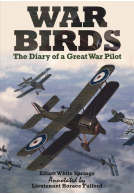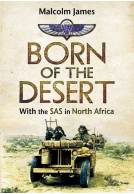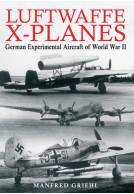Royal Flying Corps Kitbag (Hardback)
Aircrew Uniforms and Equipment from the War Over the Western Front in WWI
(click here for international delivery rates)
Need a currency converter? Check XE.com for live rates
| Other formats available - Buy the Hardback and get the eBook for free! | Price |
|---|---|
| Royal Flying Corps Kitbag ePub (68.6 MB) Add to Basket | £6.99 |
The Royal Flying Corps was formed by Royal Warrant on 13 April 1912, and came into being a month later when the Air Battalion was absorbed into the Military Wing of the new Corps in May. In the days following the outbreak of war in 1914, the programme for mobilization of the RFC was, in the main, successfully carried out. The first aircraft set out across the Channel on the morning of 13 August, taking off from Dover at 06.25 hours.
The first pilot to land in France was Lieutenant H.D. Harvey-Kelly of No.2 Squadron. In due course, all four of the initial RFC squadrons deployed to the Western Front were ready for operations. They represented, noted the Official Historian of the RFC, the ‘first organized national [air] force to fly to a war overseas’.
As the Great War raged, the developments in military aviation were profound, not only in terms of aerial warfare but, as this book reveals, the uniforms and equipment the aircrew used. All the objects that a Royal Flying Corps pilot or airman was issued with for sorties over the Western Front during the First World War are explored in this book in high-definition colour photographs, detailing everything from the differing flying clothing, to headgear, personal weapons, gloves, goggles and early life preservers. Each item is fully described, and its purpose and use explained.
Fly with the Royal Aircraft Factory B.E.2s and Sopwith Camels over the trenches and see what the RFC aircrew wore as they took on their German foe in what were the formative years of military aviation.
Highlight: Excellent photographs and very good text and descriptions. If you have an interest in the subject it's simply a must-have.
The Aerodrome Forum
Full review available at: http://www.theaerodrome.com/forum/showthread.php?p=759992#post759992
"If you want to know precisely what gear and clothing was issued to Royal Flying Corps pilots throughout the war, this book is an excellent source and a delightful read."
Indy Squadron Dispatch
It is a real eye-opener to read about the trials and tribulations involved in finding out which clothes, goggles, gloves, helmets and boots, etc. were the best in those early days of flight, which were difficult enough without being shot at, and the research and testing necessary to manufacture them.
Fascinating Facts Of The Great War
There are also chapters on paperwork and documents and on the transition from the Royal Flying Corps to the Royal Air Force. With appendices, notes and an extensive bibliography, this is a book you will want to refer to again and again.
Read the full review here
"With this book, Hillier has added to the historiography of World War I aviation by detailing the evolution of flight gear and uniforms and giving us a fine visual reference. It will please aviation historians as well as collectors and re-enactors and is highly recommended."
Argunners
Read the review here
This book, like Mark Hillier's precedents (but focused on the 1940 Battle of Britain) offers the enthusiast a way to learn about the various clothing and equipment of a RFC aviator. He does not leave aside the transition to the iconic blue RAF uniform, and above all offers a way to orient himself to any collector of these now very rare pieces. A book that therefore does not betray expectations and confirms Mark Hillier as one of the great experts in equipment and uniforms of the RFC and RAF.
On The Old Barbed Wire
Read the full Italian review here
Packed with fascinating detail, this volume gives a penetrating insight into aviation conditions 100 years ago. It is essential reading for anybody who is interested in the background to aviation in the First World War.
Society of Friends of the Fleet Air Arm
Article: 'The early days of air warfare explored in new book’
Chichester Observer, 10th June 2020 - words by Phil Hewitt
Article: 'Just how did those early RFC pilots cope?’
Shoreham Herald, 4th June 2020 – words by Phil Hewitt
An essential work in our military uniformological library.
Miniaturas JM
Read the full Spanish review here
What's not to like about this book? For the RFC enthusiast/collector and even for those with only a passing interest in this corps, this book has everything.
Paul Nixon
First and foremost, the author is a passionate enthusiast who, over the years has indulged his hobby and built up his own significant archive of everything RFC. Second, he has shared his passion in this well-written and profusely illustrated reference work which, I suspect, has already become the RFC 'bible'; the single most authoritative source for information about aircrew uniforms and equipment from the war over the Western Front during the First World War. I can't recommend this highly enough and I am sure this will be a much used source over the years to come. Well done! Superb! Grab a copy whilst you can.
Read the full review here
What's not to like about this book? For the RFC enthusiast/collector and even for those with only a passing interest in this corps, this book has everything.
Amazon Customer
First and foremost, the author is a passionate enthusiast who, over the years has indulged his hobby and built up his own significant archive of everything RFC. Second, he has shared his passion in this well-written and profusely illustrated reference work which, I suspect, has already become the RFC 'bible'; the single most authoritative source for information about aircrew uniforms and equipment from the war over the Western Front during the First World War. I can't recommend this highly enough and I am sure this will be a much used source over the years to come. Well done! Superb! Grab a copy whilst you can.
Read the full review here
Review article: 'With only the most basic kit, intrepid RFC pilots were always... WINGING IT'
RAF News, 15th May 2020 - words by Tracey Allen
This fascinating book examines in detail what Corps aircrew wore as they took on their German enemies over the trenches in what were the formative years of military aviation.
The book is a very well-produced volume with clear colour photos, interspersed throughout the text, of surviving equipment and clothing in museums or private collections, along with contemporary photos of the items in use. The text is informative and concise with extracts from relevant personal accounts. Inevitably the longest chapter is on flying clothing, but there are also chapters on flying equipment (maps, map boards, personal weapons, watches etc), uniforms, badges, and paperwork. Many enthusiasts will be able to recognise an RFC ‘Maternity Jacket’ or Sidcot suit, but, without a book such as this, for most of us a jacket or a helmet would be just a jacket or a helmet. There were several styles of such items available; a new pattern did not necessarily mean the previous one was withdrawn, so several styles might be worn by men of the same unit. It is surprising this was officially sanctioned. This was possibly because the aviation service was in its formative years without established traditions and, during a war, total replacement was not a priority. Many flying personnel bought their own flying kit, which added to the variety.
Flight Line Book Review
Read the full review here
A fascinating new addition to the unique ‘Kitbag’ series from Frontline books. Although this book contains a great many images, mostly in full colour, there is also plenty of informative text and many images are published for the first time. – Very Highly Recommended.
Firetrench
Read the full review here
This is almost another in the 100 objects series, this time looking at what Royal Flying Corps officers were required to carry in their kitbags. Fascinating!
Books Monthly
After carefully reading this book I can say that it is of exceptional quality. It is well worth the investment and the author has spent numerous hours
Dr Stuart C Blank
researching and reviewing the contents. In short, if you desire to know what the fledgling RFC aviators took into battle with them in World War 1 then you must get a copy of this book.
This book strips down the airman and looks at everything, from the uniform, to goggles, to badges, to log books to weapons and so much more. This is an excellent and well written book with a lot of very good detail. I would say these books are like a bible on it’s particular subject, if it’s not in there it’s not worth knowing about. I would very much recommend this book and those who are fans of this particular era will thoroughly enjoy the book.
UK Historian
It is sad to have to accept that there are no veterans left alive who can remember or comment on subjects like this any more, and that makes this an ever more valuable book to remember them, and what they accomplished. It is a super resource for figure modellers, along with aviation historians and I suspect for modern pilots who are interested in that history. It is also an ideal reference for militaria collectors and re-enactors, plus I suspect, for families who may still own some relics of uniforms/badges/documentation from grandfathers/great grandfathers and who would like to know a bit more about them. Excellent.
Military Model Scene, Robin Buckland
Read the full review here
This book provides as much as one could wish to know about the RFC and its pilots. By offering detailed insights into the kit they wore, much of it experimental and emerging to deal with ever changing situations, the reader gets a comprehensive view of the problems, the solutions and the people. As expected in such circumstances many of the solutions, particularly to protect from cold at altitude were the result of individuals getting things done rather than the RFC providing solutions. The profile of many individual pilots allowed them to finance better equipment until the RFC caught up and formally adopted some of the ideas. The book is a superb reference book and is graced with excellent images that add real value. Recommended.
Michael McCarthy
Michael McCarthy. Battlefield Guide
About Mark Hillier
MARK HILLIER is Head of Operations at Spitfires.com. He has a deep knowledge of the history of the RAF, with a particular focus on the Second World War. He is also a qualified pilot, having flown for more than thirty-four years as an instructor and PPL pilot. Mark has flown many different types of aircraft from gliders to vintage tailwheel types, including the DH Chipmunk, Boeing Stearman and T6 Texan. He has previously written or co-authored fourteen successful books on aviation, including the authorised biography of Wing Commander Thomas Murray DSO, DFC and Bar, contributed numerous magazine articles, advised, and appeared on, a number of television programmes, and is a regular public speaker on aviation matters.























